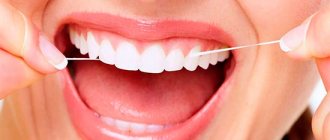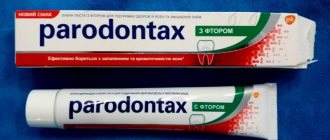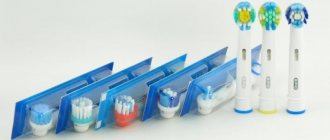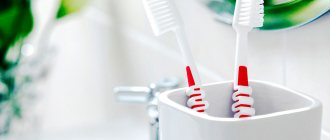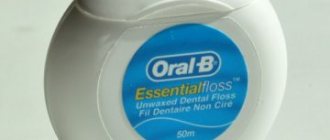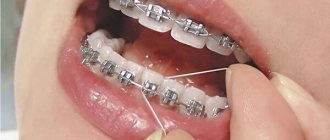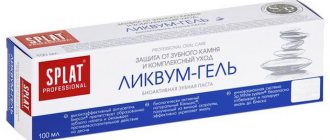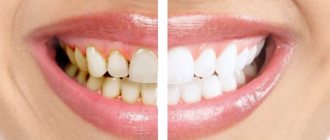Dental floss is an oral hygiene product that helps clean the interdental spaces. It is in these areas that the most plaque and food debris accumulate, which create a favorable environment for the development of caries. No brush can fit into these spaces, so flossing is not an alternative, but an important addition to your daily hygiene routine to keep your smile healthy and beautiful. To choose the one that's best for you, weigh the pros and cons of both types of waxed and unwaxed dental floss.
What is dental floss used for?
Floss easily copes with the difficult task of cleaning the interdental spaces. This hygiene product is especially recommended for people with crowded teeth and those undergoing treatment with braces. Timely removal of residues prevents the development of caries and gum disease. Many people believe that a toothpick is sufficient for this purpose. Dentists have a unanimous opinion on this matter: a toothpick, unlike floss, only harms the teeth.
Lanshina Natalya Viktorovna
hygienist at pediatric dentistry “Zubrenok”
The difference between dental floss and a toothpick is fundamental. Properly selected dental floss, when used correctly, removes plaque and food debris from the interdental spaces and does not injure the oral mucosa and the ligaments that hold the tooth in the bone. This is a means of dental care, prevention of caries and periodontal diseases. A toothpick is used to remove food stuck between teeth, in cavities, or under the gum. It injures the gums and ligaments of the tooth, leaving microbial plaque intact. People who use a toothpick have some kind of unresolved dental problem, a chronic disease in the oral cavity that requires emergency dental care
Rules for using waxed and unwaxed floss
The rules for using waxed and unwaxed dental floss are almost the same. In order not to damage the tissue and efficiently clean the interdental spaces, you need to know the main points.
- Brushing your teeth should only be done with clean hands.
It is very important to learn how to use dental floss correctly.
- For a hygienic procedure, up to 50 centimeters of floss is unwound.
- The thread is wound around one or two fingers of one hand, then onto the fingers of the other hand. The distance of the thread remaining between the fingers is about 5 centimeters.
- The remaining free part of the thread, stretched like a string, is used to clean the space between the teeth. Before each new surface, the floss is rewound to prevent the transfer of bacteria from the contaminated area to a new place.
- The approximate number of slides is 7. The movement goes from the root of the tooth to its cutting surface. When using unwaxed thread, a squeaking sound is heard when the hygiene is done properly and it can be completed.
How to floss your teeth
- Care must be taken not to cut the gum and make smooth movements. People with dense teeth should pay special attention to this, since the efforts made to penetrate the floss can lead to its sudden displacement.
- The first time you try to use dental floss, you may damage your gums. With proper general oral hygiene, this will not harm your health. With regular practice, the problem of soft tissue cuts disappears.
With dental floss, practice is key.
Attention! Simple sewing thread is not suitable for cleaning interdental spaces!
The choice of waxed or unwaxed floss depends on several factors - the ability to use this hygiene product and the structural features of the dentition. For better cleaning, unwaxed thread is suitable, and for those who are afraid or do not know how to manage floss - waxed thread. Using any type of dental floss helps to significantly reduce the risk of developing caries and tartar deposits. Read about nitrous oxide in dentistry on our website.
What dental floss is best to use?
The choice depends on the characteristics and condition of your teeth. First of all, we recommend deciding on the shape of the dental floss.
- Round floss is designed for normal and wide spaces between teeth.
- Tape floss is recommended for those who have gaps between teeth - trema and diastema.
- Flat floss is suitable for people with narrow interdental spaces.
The best dental floss is the one that is perfect for you. The health of your teeth and gums depends on the correctly chosen form. A small thread diameter will make cleaning ineffective, and a wide thread can injure the gums. If in doubt, consult your dentist about which dental floss is best for you.
Lanshina Natalya Viktorovna
hygienist at pediatric dentistry “Zubrenok”
The choice of dental floss should be individual. The hygienist or dentist knows all the nuances that need to be taken into account. Waxed and flat threads penetrate more easily into hard-to-reach places in the presence of orthopedic structures and crowded teeth. Unwaxed - better clean the contact surfaces of teeth from food debris and accumulation of bacteria. This type of floss is recommended for patients who regularly take care of their teeth, have a relatively healthy mouth, and do not have many fillings or crowded teeth. Threads that swell under the influence of saliva, as well as round cross-section, are characterized by increased atraumaticity. They clean wide interdental spaces well. Flosses are impregnated with deodorizing components and medicinal additives to fight bacteria and inflammation.
Dental floss can be made from natural material - silk (it is not very durable and is quite rare) and from artificial material, such as nylon or nylon.
Differences
In the floss production process, synthetic materials (nylon, nylon or acetate) are used, less often natural silk. A thread may consist of one or more fibers.
The difference lies in the method of additional surface treatment; products can be:
- impregnated with beeswax;
- raw threads.
How are they different from each other? Waxed floss is often impregnated with sodium fluoride , which has a preventive anti-caries effect, and menthol, which deodorizes the oral cavity.
Fluorine and chlorhexidine, used more often in the manufacture of unwaxed products, have a bactericidal effect and serve as a softening agent for the thread: in terms of sliding speed, such a product is more reminiscent of floss impregnated with the waste product of bees.
Waxed dental floss
Waxed dental floss has a smooth surface, making it easy to glide between teeth. We recommend it for those who are just starting to use dental floss: the risk of gum injury is significantly reduced. Waxed dental floss is durable, does not tear, and has a long shelf life - from 5 years. The only drawback: impregnated floss does not remove plaque very well - it is smooth and quickly slips in the interdental spaces.
What types of impregnations are there?
- Chlorhexidine - antibacterial, disinfecting effect of Curaprox DF 820.
- Herbal extracts help gums stay healthy.
- Potassium nitrate - caries prevention PresiDENT Sensitive.
- Menthol, mint - fresh breath Donfeel UF-623.
The impregnated mini-floss is convenient to carry with you - even in a handbag it does not take up much space (Donfeel Dental Floss mini-floss). The price of this thread is lower, since it is not very long.
Advantages and disadvantages of products
To choose the most suitable dental floss model, you need to have an idea of what is good about each of them and what disadvantages they have. Let's start with, perhaps, the simplest option - unwaxed thread. Among the strengths of the product are:
- The ability of the thread to “fluff”. Allows you to capture a larger tooth surface and remove more plaque.
- The floss fits tightly to the teeth. Allows you to remove dirt more effectively.
- Hypoallergenic. Due to the fact that there is no impregnation on the floss, natural fiber is completely safe and will not cause a negative reaction from the body.
On the other hand, the advantages of unwaxed thread can become its disadvantages. For example, the tightness of the thread is ensured by its insufficient slipperiness. If you make sudden movements with your hands, such a floss can cause injury to your gums, which means you should handle unwaxed floss very carefully. In addition, the lack of impregnation significantly reduces the shelf life of the product (no more than 3 years).
Waxed thread is safer precisely because of its impregnation. Dentists recommend such threads for young children and patients who have no experience with flossing. Waxed threads are also highly durable: the likelihood that the thread will break during the procedure is minimal. Waxed thread is stored longer (up to 5 years) and often contains additional components in the impregnation that protect against caries and effectively freshen breath.
The benefits and harms of using hygiene products
Floss as a hygiene product has a lot of advantages: it is good as a tool for cleaning teeth in hard-to-reach places where a toothbrush cannot penetrate, it protects the oral cavity from harmful bacteria, it is affordable and suitable for children and adults. It is impossible not to mention the disadvantages:
- if used insufficiently carefully, you can injure tender gums, which will result in an inflammatory process, which, in the absence of qualified medical care, can result in tooth loss;
- due to frequent and too vigorous brushing, gums may begin to bleed;
- Dentists consider periodontitis a contraindication for flossing, so if you notice blood, flossing should be stopped;
- floss is not an independent hygiene product; it should be used in combination with a toothbrush, toothpaste and mouth rinse - this is the only way to maintain a snow-white smile;
- experts note that in their practice there are cases of partial or complete destruction of diseased teeth due to the use of floss, so before you buy floss in a store, check with your dentist about the advisability of its use.
Sources:
- https://www.zdoroviemed.ru/stati/kak-pravilno-polzovatsya-zubnoj-nityu-poshagovaya-instrukcziya/
- https://24stoma.ru/zubnaya-nit.html
- https://dr-zubov.ru/krasota-i-uxod/sredstva/zubnye-niti/kak-pravilno-i-bezopasno-polzovatsya.html
- https://dentamed.club/gigiena/profilaktika/kak-polzovatsya-zubnoy-nityu.html
- https://MikDent.ru/estetika/uhod/kak-polzovatsya-zubnoj-nityu.html
- https://familystr.com/eto-interesno/poleznie-soveti/kak-polzovatsya-zubnoj-nitju/
At what age are children allowed?
A child can use floss independently no earlier than 10 years old, but you can start getting acquainted with it much earlier.
First, parents themselves must clean the interdental spaces in the child’s mouth, and over time teach the child to carry out this procedure independently. However, some dentists do not recommend using floss before the age of 12, and explain this by the fact that:
- a child’s mucous membrane is very delicate and can be easily injured;
- not all milk teeth have been replaced by permanent ones;
- the child may make sudden movements with the floss, which will cause bleeding gums and inflammation.
Important! The child should carry out the first few independent procedures for flossing his teeth under the supervision of his parents.
How to choose the right floss
First of all, pay attention to the quality of the product. If a certified product is important to you, then purchase floss in pharmacies. High-quality products are distinguished by natural materials and are made on a silk base (waxed or unwaxed). They do not get stuck between the teeth and do not tear prematurely.
If this is a fake, then there can be no talk of any silk threads. The floss material is nylon or nylon. The main difference between the best quality brand and a fake is the price and place of sale. Low-quality floss can be sold anywhere except pharmacies.
Important Application Tips
So that you can successfully master this device and get the most out of it, follow these recommendations:
- don’t skimp, you’ll need a fairly long piece for comfortable grip;
- The cleaning procedure must be regular - repeat it daily before bed;
- During the cleaning process, try not to put too much pressure on your gums, so as not to damage them and cause bleeding;
- do not pull the floss under any circumstances, all your movements should be slow and careful;
- if you have quite significant gaps between your teeth, use round floss;
- if the teeth are pressed tightly, choose flat;
- children can use floss, but from the age of 8-10, when they are already able to use it adequately and safely, until this age it is important for them to learn how to brush their teeth correctly;
- If the thread breaks or flakes heavily during the process, this may be a sign of problems in the contact areas of your teeth (such as overhanging fillings or contact caries).
And most importantly, remember: dental floss is not an adequate replacement for toothpaste and brushes. But it is only their important and significant addition!
And if you apply all this together correctly, your teeth and gums will definitely thank you.
